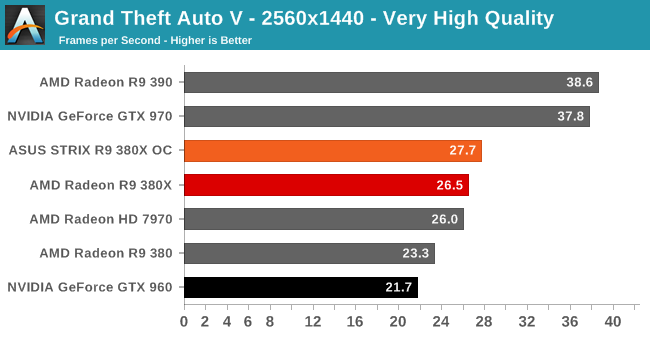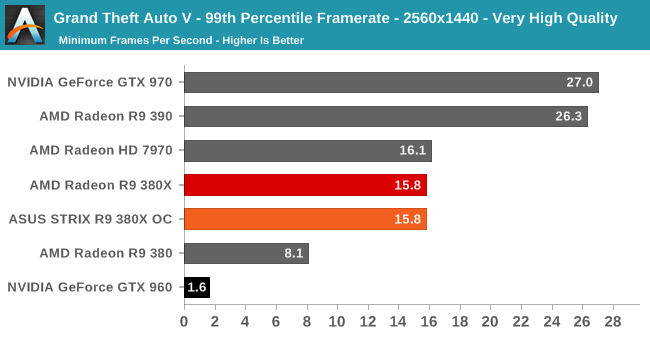The AMD Radeon R9 380X Review, Feat. ASUS STRIX
by Ryan Smith on November 23, 2015 8:30 AM EST- Posted in
- GPUs
- AMD
- Radeon
- Asus
- Radeon 300
Grand Theft Auto V
The open world action game in our benchmark suite is also the last game in our suite: Grand Theft Auto V. The latest edition of Rockstar’s venerable series of open world games, Grand Theft Auto V was originally released to the last-gen consoles back in 2013. However thanks to a rather significant facelift for the current-gen consoles and PCs, along with the ability to greatly turn up rendering distances and add other features like MSAA and more realistic shadows, the end result is a game that is still among the most stressful of our benchmarks when all of its features are turned up.
On a quick note about settings, as Grand Theft Auto V doesn't have pre-defined settings tiers, I want to quickly note what settings we're using. For "Very High" quality we have all of the primary graphics settings turned up to their highest setting, with the exception of grass, which is at its own very high setting. Meanwhile 4x MSAA is enabled for direct views and reflections. This setting also involves turning on some of the advanced redering features - the game's long shadows, high resolution shadows, and high definition flight streaming - but not increasing the view distance any further.


Grand Theft Auto V is another game that punishes 2GB cards to a degree, which plays into the R9 380X’s favor. At 1080p this helps to keep the card 11% ahead of the GTX 960 and 5% ahead of the R9 380. That said, GTA is the one game where perhaps even the R9 380X isn’t powerful enough for no-compromises 1080p gaming, and while 38fps is more than playable (this was a 30fps console game), the 60fps PC standard will require giving up MSAA to hit that mark.


Meanwhile the 99th percentile framerates further drive home the point about 2GB cards being insufficient. However it also points out how even the R9 380X can’t stay above 30fps at all times, reiterating what we said above about possibly needing to drop MSAA to get the best 1080p performance on the R9 380X.










101 Comments
View All Comments
CaedenV - Monday, November 23, 2015 - link
My guess is that these cards are factory OC'd, which means that they would need to be underclocked to run an apples-to-apples comparison at true 'stock' settings.Zeus Hai - Monday, November 23, 2015 - link
Can anyone confirm that AMD's Frame Limiter still doesn't work on Windows 10?nathanddrews - Monday, November 23, 2015 - link
That's news to me.Just for you, I tested it using my i3-2100/HD7750/W10 test mule. VSync globally disabled in CCC, VSync disabled in Dota 2, Frame Target set to 60fps. Steam overlay shows 60fps and I see no signs of tearing or stuttering. To my knowledge, it never stopped working.
Zeus Hai - Monday, November 23, 2015 - link
Hmm.., it should have some tearing because it doesnt really sync with the monitor anyway, mate. Can you set it to 65, 70, 75? Mine doesnt work in LoL, I set it to 60, but it always fires up over 150fps+Dirk_Funk - Monday, November 23, 2015 - link
LoL does have its own fps limiter, so perhaps that's causing a mix-up in the software. Also, LoL might be running in fake fullscreen mode whereas the catalyst fps limiter specifies it will "Reduce power consumption by running full-screen applications at reduced frame rates." I'm gonna go try a round of LoL now because you have me curious.Asomething - Tuesday, November 24, 2015 - link
Mine does, was just benching my new 290x and forgot to turn it off so my results were skewed by the 75fps frame cap i set.nirolf - Monday, November 23, 2015 - link
There's "ASUS R9 Fury OC" mentioned in the first table in the Overclocking section.Ryan Smith - Monday, November 23, 2015 - link
Thanks.Shadowmaster625 - Monday, November 23, 2015 - link
Tonga is an epic disaster. It is less than 10% more efficient than tahiti in terms of performance per watt, and in terms of performance per transistor (fps per mm^2) it apeears to be actually worse. Meanwhile, Nvidia releases maxwell which outperformas kepler on both these metrics not by some paltry 10% or less, but by a very wide margin.CiccioB - Tuesday, November 24, 2015 - link
All the GCN architecture is a disaster.With TeraScale architecture AMD could fight with smaller dies and less W for a bit less performance.
With GCN AMD has to compete using larger and power hungry dies that have brought it to go in red also in the graphics division, while with older TeraScale it at least could be at least on par.
GCN is an architecture not up with that of the competition.
DP64 presence is not the problem, as AMD has kept on reducing it influence over every GCN step (starting from 1/4FP and ending to 1/24FP) with no real results under the power consumption term. They probably could just spare few mm^2 on the die, but they are too way back with memory compression (I can't really believe they never thought about that) and their bus are way too big, expensive and power hungry.
All the architecture is a fail. And DX12 is not going to solve anything, as if they ever raise their performances of 10% over the competition, they are still way back in efficiency both in terms of W and die size.